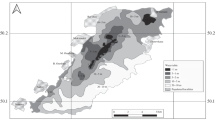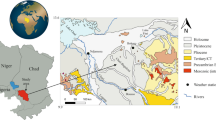Abstract.
Morphogenetic depressions or "dishes" in the Chernobyl exclusion zone play an important role in the transport of water and solutes (in particular the radionuclides 137Cs and 90Sr), functioning as accumulation basins and facilitating their transfer between the surface and subsurface via return flow (under conditions of high soil water saturation) and infiltration. From a digital elevation model (DEM) of the 112-km2 study area, 583 dishes (covering about 10% of the area) are identified and classified into four geometric types, ranging in size from 2,500 to 22,500 m2, and a with a maximum depth of 2 m. The collective influence of these depressions on the hydrology of the study basin is investigated with a coupled model of three-dimensional saturated and unsaturated subsurface flow and one-dimensional (along the rill or channel direction s) hill-slope and stream overland flow. Special attention is given to the handling of dishes, applying a "lake boundary-following" procedure in the topographic analysis, a level pool routing algorithm to simulate the storage and retardation effects of these reservoirs, and a higher hydraulic conductivity in the topmost 3 m of soil relative to non-dish cells in accordance with field observations. Modeling the interactions between the surface and subsurface hydrologic regimes requires careful consideration of the distinction between potential and actual atmospheric fluxes and their conversion to ponding, overland flow, and infiltration, and this coupling is described in some detail. Further consideration is given to the treatment of snow accumulation, snowmelt, and soil freezing and thawing processes, handled via linear and step function variations over the winter months in atmospheric boundary conditions and in upper soil hydraulic conductivities. A 1-year simulation of the entire watershed is used to analyze the water table response and, at the surface, the ponding heads and the infiltration/exfiltration fluxes. Saturation patterns and return flow and seepage fluxes are similar between the dishes and the main channel networks, with, as expected, preferential infiltration in the dishes.
Similar content being viewed by others
Author information
Authors and Affiliations
Additional information
Electronic Publication
Rights and permissions
About this article
Cite this article
Bixio, A., Gambolati, G., Paniconi, C. et al. Modeling groundwater-surface water interactions including effects of morphogenetic depressions in the Chernobyl exclusion zone. Env Geol 42, 162–177 (2002). https://doi.org/10.1007/s00254-001-0486-7
Received:
Accepted:
Published:
Issue Date:
DOI: https://doi.org/10.1007/s00254-001-0486-7




